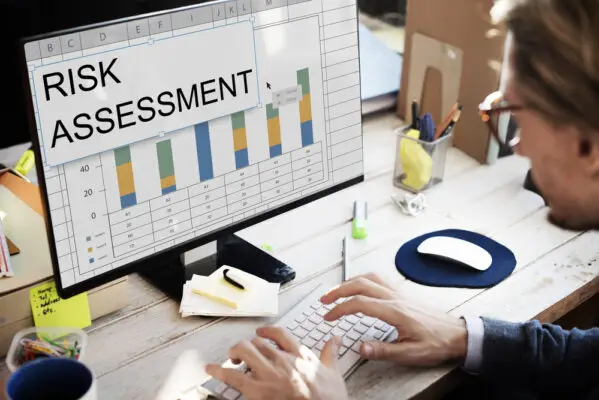Control risk and risk assessment are concepts in auditing and risk management. Understanding control risk is crucial for organizations to effectively evaluate and manage potential risks that may hinder the achievement of their objectives.
Control risk refers to the likelihood that controls within an organization’s system will fail to prevent or detect errors or irregularities in financial statements.
On the other hand, risk assessment involves identifying, analyzing, and evaluating risks that may impact an organization’s ability to achieve its goals. It is a systematic process that enables organizations to prioritize risks based on their significance and develop appropriate strategies to mitigate them.
Organizations can gain insights into their vulnerabilities by conducting effective risk assessments, making informed decisions, and implementing robust control measures.
This article explores the definition of control risk and risk assessment, highlighting their importance in managing organizational risks effectively.
Furthermore, it delves into techniques for mitigating control risks as well as best practices for conducting thorough and comprehensive risk assessments.

Understanding Control Risk
Control risk is a concept that pertains to the possibility of errors or irregularities occurring in financial statements due to ineffective internal controls within an organization.
It is an essential component of the overall risk assessment process. Control risk analysis involves evaluating the effectiveness of internal controls and identifying potential weaknesses that could lead to material misstatements in financial reporting.
This analysis helps organizations determine the level of reliance they can place on their internal control systems.
Effective risk management strategies aim to mitigate control risk by implementing strong internal controls, such as segregation of duties, regular monitoring and testing procedures, and clear communication channels.
These strategies also involve ongoing monitoring and evaluation to ensure that controls remain effective over time.
Organizations can protect themselves from potential financial statement errors or fraud by understanding control risk and implementing appropriate risk management strategies.
The Importance of Risk Assessment
Significant attention is dedicated to evaluating potential risks in order to enhance decision-making processes and minimize the occurrence of adverse events.
Risk assessment plays a crucial role in decision-making by providing valuable insights into the potential impact of various risks on business objectives.
Identifying and analyzing risks, organizations can develop effective strategies and implement appropriate controls to mitigate those risks. This allows for better allocation of resources, improved planning, and informed decision-making.
Risk assessment also helps in aligning risk management with business strategy. It enables organizations to identify opportunities and threats that may arise from their strategic initiatives, helping them make more informed decisions about resource allocation and risk tolerance.
Integrating risk assessment into the overall strategic planning process, organizations can proactively identify potential risks and develop strategies to capitalize on opportunities while minimizing exposure.
The table below illustrates the relationship between risk assessment and business strategy:
| Risk Assessment | Business Strategy |
|---|---|
| Identifies potential risks | Helps in setting strategic objectives |
| Analyzes the impact of risks | Determines resource allocation |
| Develops mitigation strategies | Guides decision making |
| Aligns risk management with strategy | Enhances organizational resilience |
Risk assessment is essential for effective decision-making as it provides insights into potential risks, helps align risk management with business strategy, and enhances organizational resilience.

Mitigating Control Risk
In order to mitigate control risk, organizations should focus on implementing strong internal control systems. These systems are designed to provide a framework for effectively managing and monitoring key business processes.
Additionally, regular monitoring and evaluation of control measures is essential to ensure that they are operating effectively and efficiently.
This ongoing assessment helps identify any weaknesses or gaps in the controls, allowing for timely corrective actions to be taken.
Implementing Strong Internal Control Systems
Implementing robust internal control systems is crucial for organizations to manage and mitigate risks effectively.
Strengthening internal controls helps detect and prevent errors, fraud, and non-compliance with regulations and ensures the reliability of financial reporting.
Establishing strong internal control systems, organizations can enhance operational efficiency, safeguard assets, and maintain the integrity of their processes.
To implement strong internal control systems, organizations should follow risk management strategies, including identifying key risks, assessing their potential impact on operations, and designing controls to mitigate them.
This involves creating a system of checks and balances, segregating duties appropriately, implementing regular monitoring procedures, conducting periodic audits, and promoting a culture of ethical behaviour throughout the organization.
Table:Strategies for Implementing Strong Internal Control Systems
| Strategies for Implementing Strong Internal Control Systems |
|---|
| Identify key risks |
| Assess potential impact |
| Design controls |
| Regular monitoring |
Adopting these strategies and continually evaluating the effectiveness of their internal control systems, organizations can proactively address control risk and minimize the likelihood of adverse events occurring.
Regular Monitoring and Evaluation of Control Measures
A crucial aspect of maintaining strong internal control systems is regularly monitoring and evaluating control measures. This enables organizations to proactively identify any weaknesses or gaps in their processes and make necessary improvements.
Monitoring effectiveness involves the ongoing assessment of control activities to determine if they are operating as intended. This can be done through various methods such as periodic reviews, data analysis, and testing.
Conversely, control evaluation involves a more comprehensive examination of controls to assess their design effectiveness and implementation.
This typically includes conducting risk assessments, evaluating control documentation, and performing walkthroughs to ensure that controls are adequately designed and implemented.
Regularly monitoring and evaluating control measures, organizations can gain insights into the effectiveness of their internal controls and take corrective actions when needed to mitigate potential risks or failures.
Conducting Effective Risk Assessments
This paragraph will discuss the importance of utilizing risk assessment tools and techniques as well as involving stakeholders in the risk assessment process.
Utilizing risk assessment tools and techniques is crucial for organizations to identify, analyze, and evaluate potential risks effectively.
These tools can include methods such as checklists, interviews, and surveys that provide a structured approach to assessing risks.
Involving stakeholders in the risk assessment process allows for a comprehensive understanding of various perspectives and expertise, which enhances the accuracy and credibility of the risk assessment results.
Utilizing Risk Assessment Tools and Techniques
Risk assessment tools and techniques play an integral role in evaluating and mitigating potential risks within an organization’s control environment. These tools provide a systematic approach to identifying, analyzing, and prioritizing risks based on their likelihood and impact.
One commonly used technique is the risk matrix, which categorizes risks into different levels of severity to facilitate decision-making.
Another effective tool is the risk register, which documents identified risks and relevant information such as their causes, consequences, and control measures.
Additionally, organizations can utilize scenario analysis to assess the impact of various risk scenarios on their operations.
This technique involves creating hypothetical scenarios and analyzing their potential outcomes to determine appropriate risk response strategies.
Utilizing these risk assessment techniques and tools enables organizations to proactively manage risks by implementing appropriate control measures and monitoring their effectiveness over time.
Involving Stakeholders in the Risk Assessment Process
In the previous subtopic, we discussed the utilization of risk assessment tools and techniques. Building upon that, the current subtopic focuses on involving stakeholders in the risk assessment process.
Stakeholder engagement is crucial in ensuring a comprehensive understanding of potential risks and their implications for an organization.
A wider range of perspectives can be considered during risk identification by actively involving stakeholders such as senior management, employees, customers, and external partners.
Stakeholders bring unique insights and expertise to the table, enabling a more thorough analysis of potential risks. Their involvement enhances transparency and accountability throughout the risk assessment process.
Additionally, engaging stakeholders fosters buy-in and commitment to risk mitigation strategies since they have been part of the decision-making process from the early stages.
Involving stakeholders in risk assessment provides a complete understanding of organizational risks and encourages cooperation and shared responsibility in effectively managing those risks. This approach promotes a holistic approach to risk management.
Integrating Control Risk and Risk Assessment
Integrating control risk and risk assessment allows for a comprehensive evaluation of potential risks and the effectiveness of internal controls in minimizing those risks.
Combining these two processes, organizations can obtain a more holistic understanding of their risk landscape and make informed decisions regarding control implementation.
This integration involves several key steps:
- Develop a control risk management framework: Establish a framework that outlines the organization’s objectives, identifies risks, and defines control activities to mitigate those risks.
- Identify inherent risks: Assess the nature and magnitude of inherent risks within the organization’s operations, including internal and external factors.
- Evaluate existing controls: Analyze the effectiveness of current control measures in managing identified risks.
- Enhance controls as necessary: Identify gaps in existing controls and implement additional measures to strengthen risk mitigation efforts.
Organizations can improve their risk management by combining control risk management and risk assessment frameworks. This proactive approach helps identify vulnerabilities, boost internal controls, and reduce potential threats to their operations.
Frequently Asked Questions
What are the different types of control risks that organizations commonly face?
Organizations commonly face different types of control risks, including inherent risks, control deficiencies, and management overrides.
Control risk relates to the likelihood that internal controls will not prevent or detect material misstatements in financial statements. Emerging technologies pose additional challenges for control risk assessment.
How does control risk differ from inherent risk and detection risk?
Control risk differs from inherent risk and detection risk in that it focuses on the likelihood of misstatements occurring due to failures in an organization’s internal controls.
Inherent risk relates to the susceptibility of a financial statement assertion to material misstatement and detection risk refers to the risk that an auditor will not detect a material misstatement.
What are the key steps involved in conducting an effective risk assessment?
The key steps in conducting an effective risk assessment include: identifying hazards and potential risks, assessing the likelihood and impact of each risk, and prioritizing risks based on their significance.
Developing appropriate control measures, implementing controls, and regularly reviewing and updating the risk assessment framework.
How can organizations effectively mitigate control risk in their operations?
Organizations can implement various control risk management strategies to effectively mitigate control risk in their operations.
Best practices for control risk mitigation include implementing internal controls, conducting regular assessments, and monitoring and reviewing processes to identify and address potential risks.
What are some common challenges faced by organizations when integrating control risk and risk assessment processes?
Some common challenges faced by organizations in integrating control risk and risk assessment processes include resistance to change, lack of resources, inadequate training, coordination difficulties, and ensuring consistency and accuracy in the implementation of risk assessment.

Conclusion
Control risk is a crucial aspect of any organization’s risk management process. It refers to the potential for errors, fraud, or non-compliance in internal controls that could lead to material misstatements in financial statements.
On the other hand, risk assessment involves identifying and evaluating risks to determine their significance and likelihood of occurrence. By conducting effective risk assessments, organizations can make informed decisions about control activities and implement measures to mitigate control risk.
Integrating control risk and risk assessment enables organizations to enhance their overall risk management framework.
In conclusion, control risk and risk assessment play significant roles in an organization’s risk management process. Understanding control risk helps identify areas where internal controls may be weak or ineffective, while effective risk assessments allow for informed decision-making regarding control activities.
By integrating these two concepts into their overall risk management framework, organizations can effectively mitigate control risks and safeguard against potential material misstatements in financial statements.

Chris Ekai is a Risk Management expert with over 10 years of experience in the field. He has a Master’s(MSc) degree in Risk Management from University of Portsmouth and is a CPA and Finance professional. He currently works as a Content Manager at Risk Publishing, writing about Enterprise Risk Management, Business Continuity Management and Project Management.

